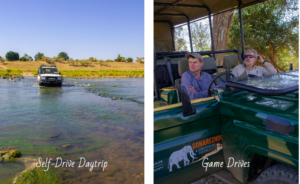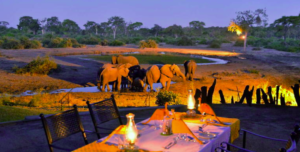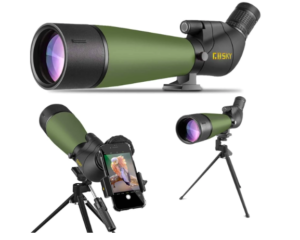Alaska Black Bear Hunting.
Alaska, sometimes known as the Last Frontier, is home to one of North America’s most sought-after hunting experiences which is the black bear hunting. Alaska’s immense wilderness, deep woods, and robust black bear populations provide hunters with an outstanding chance to chase these elusive and spectacular beasts. Whether you are a seasoned hunter looking for an exciting adventure or a novice looking to put your abilities to the test, black bear hunting in Alaska promises to be an amazing experience.
Black bears in Alaska are famous for their size, power, and extraordinary adaptation to the harsh terrain. From coastal rainforests to alpine meadows, the state’s various ecosystems provide great habitat for black bears, offering a variety of hunting situations and difficulties.
The anticipation grows as you maneuver through deep forests, stalk down rivers, or examine mountain slopes, knowing that you may come face to face with one of Alaska’s majestic black bears at any time.
This guide will take you on a journey through the world of black bear hunting in Alaska, including themes like hunting legislation, hunting tactics, gear and equipment, safety concerns, and the entire hunting experience. Whether you like spot-and-stalk hunting, baiting, or pursuing bears with dogs.
What are the bear hunting seasons in Alaska?
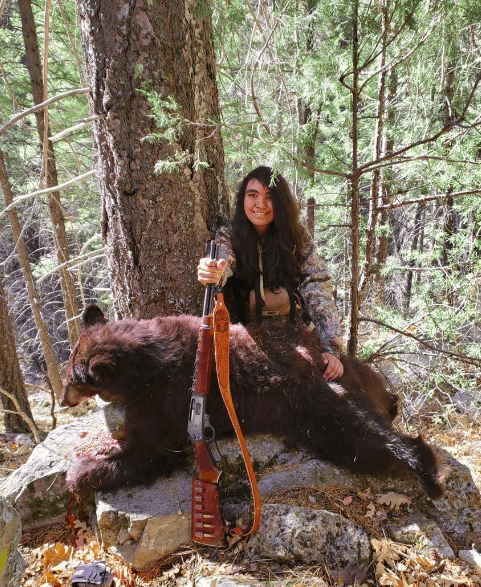
Bear hunting seasons in Alaska vary based on the kind of bear and the location where the hunt takes place. Bear hunting seasons are subject to change, thus the most up-to-date information should be obtained from the Alaska Department of Fish and Game (ADFG) and local laws. Here’s a rundown of Alaska’s bear hunting seasons.
The Black Bear:
General Season:
In Alaska, the regular black bear hunting season normally spans from spring through autumn, from April/May to September/October. The exact dates might vary depending on the hunting unit and location. Spring seasons are frequently devoted to capturing bears emerging from their dens, but fall seasons may coincide with salmon streams.
Permits for Registration:
For black bear hunts, some hunting units require registration licenses. Season dates and bag limitations may be specified in these licenses. Details about particular units can be found on the ADFG website or in local rules.
The Brown Bear:
Spring Season:
Spring brown bear hunting seasons typically begin in April and go until early June. These seasons typically target bears when they emerge from hibernation and seek food along riverbanks and near coastlines. Drawing permits or guiding services are frequently required for spring hunts.
Autumn Season:
Brown bear hunting seasons in the fall run from September to November, coinciding with salmon spawning season. This time of year provides possibilities to hunt bears that eat in fish-rich streams and rivers. Autumn hunts may also need licenses or be led.
The Grizzly Bear:
Regulations and Seasons:
Seasons and rules for grizzly bear hunting vary by location and hunting unit. Some locations may have grizzly bear harvest seasons, whilst in others, grizzly bears may be subject to black bear hunting laws. For detailed specifics, it is critical to examine local rules.
It is vital to remember that bear hunting in Alaska is subject to certain rules and restrictions, such as licenses, permits, and required reporting of killed bears. These restrictions are intended to guarantee sustainable hunting practices and bear population conservation.
Furthermore, hunting tactics, bag limits, and the use of bait or dogs may be restricted in particular hunting units or locations. To become acquainted with the relevant regulations, always contact the ADFG website or local authorities.
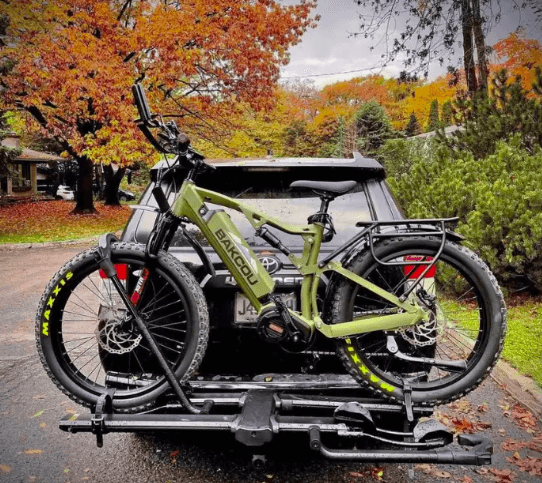
Alaska Bear Hunting Locations.
Throughout Alaska’s wide and diverse landscapes, there are various bear-hunting units. Here’s a rundown of some of Alaska’s bear hunting units and their locations:
Prince of Wales Unit 1:
Location:
Prince of Wales Island, located in southeastern Alaska, is the third-largest island in the United States. It is also part the Alexander Archipelago.
Bears:
The unit allows for both black bear and brown bear hunts.
Kodiak Archipelago, Unit 6:
Location:
The Kodiak Archipelago is located south of the mainland in southwestern Alaska. The main island in this region is Kodiak Island.
Bears:
Unit 6 is famous for its iconic Kodiak brown bears and provides world-class brown bear hunting possibilities.
Eastern Alaska Range, Unit 9:
Location:
Unit 9 is situated in the eastern section of the Alaska Range, between the Tok and Richardson Highways.
Bears:
This unit offers both black bear and brown bear hunting chances.
Upper Copper River Unit 13:
Location:
Unit 13 encompasses the upper sections of the Copper River and neighboring lands in southcentral Alaska.
Bears:
This unit allows for both black bear and brown bear hunts.
Kenai Peninsula, Unit 16:
Location:
The Kenai Peninsula extends into the Gulf of Alaska south of Anchorage. It is a well-known tourist attraction due to its picturesque splendor.
Bears:
Unit 16 offers both black and brown bear hunting chances.
Chugach Range, Unit 19:
Unit 19 encompasses the Chugach Mountains, a coastal mountain range in southcentral Alaska.
Bears:
This unit has both black and brown bear hunting potential.
These are just a handful bear hunting units in Alaska; there are many more around the state.Check out What is takes to hunt bears in New York , Arkansas, Vermont, Each unit has its own set of hunting rules, seasons, and criteria.
For complete information on each unit, including precise borders, hunting techniques, bag limits, and any additional limitations or requirements, check the Alaska Department of Fish and Game (ADFG) and local hunting rules.
When arranging a bear hunting trip in Alaska, it is best to do your homework and acquire the most up-to-date information on the individual units you want to hunt in, as restrictions and borders might vary from year to year. Furthermore, enlisting the help of an experienced hunting guide or outfitter may give vital expertise and improve your entire hunting experience.
How to Obtain a Beer Hunting permit in Alaska.
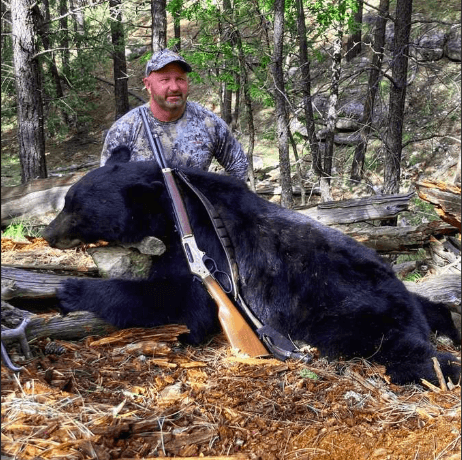
Certain actions and procedures must be followed in order to apply for a bear hunting licence in Alaska. The following is a general guide to applying for a bear hunting permit in Alaska:
Choose a Bear Species and a Hunting Unit:
Determine which bear species you want to hunt, whether black bears, brown bears, or grizzly bears. Investigate the several hunting units in Alaska where these bear species can be found.
Examine the Hunting Regulations:
Learn about the hunting restrictions established by the Alaska Department of Fish and Game (ADFG). Regulations differ based on the type of bear, hunting unit, and resident status.
Examine the Application Period and Deadlines:
Determine the application period and deadlines for the bear hunting permit in question.
Obtain the Required Licenses:
To apply for a bear hunting permit, be sure you have all of the necessary permissions. A valid Alaska hunting license is required. You may require extra licenses as a non-resident, such as a Non-Resident Alien Hunting License if applicable.
Fill out the application:
The ADFG website has a bear hunting permit application form, or you may contact their office directly. Fill out the application completely and precisely, including personal information, hunting unit, bear species, and chosen hunting dates.
Payment of the Application Fee:
Along with the completed application, send in the application fee. The application cost varies per bear species and hunting unit. Regardless of the outcome of the permit draw, the cost is usually non-refundable.
Submit the Application:
Send the completed application form and the application fee to the ADFG’s address. Ensure that it arrives at the ADFG office before the deadline.
Follow the Permit Draw:
The ADFG will hold a permit draw after the application deadline to assign permits for the available hunting units. The results of the draw will be available on the ADFG website, and successful candidates will be contacted by mail or email.
Purchase a Bear Hunting License:
If your name is drawn in the permit draw, you must acquire a bear hunting permit. To receive your permission, follow the ADFG’s procedures. The permit fee is determined on the bear species, hunting unit, and resident status.
It is crucial to note that the application procedure and conditions may differ depending on the bear species, hunting units, and resident status. For the most accurate and up-to-date information about applying for bear hunting licenses in Alaska, it is suggested that you thoroughly research the particular regulations and guidelines published by the Alaska Department of Fish and Game.
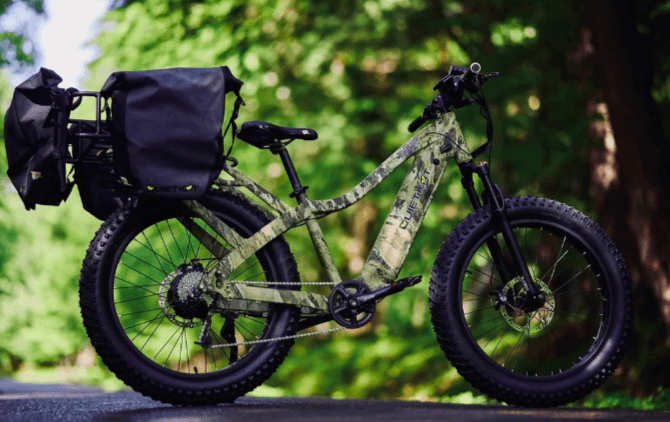
How To Hunt Bears in Alaska
Bear hunting necessitates meticulous preparation, understanding of bear habits, and obedience to hunting restrictions. Here’s a general guide on bear hunting:
Obtain All Required Licenses and Permits:
Make sure you have the necessary hunting licenses and permits from the jurisdiction where you intend to hunt bears. Familiarize oneself with the individual bear hunting laws and limits in that location.
Learn Bear Habitat and Behavior:
Learn about the bear species you want to hunt, including their habitat preferences, eating patterns, and behavior. Understanding their behaviors can assist you in locating prospective hunting grounds.
Scout Hunting Spots:
Scout any prospective hunting grounds thoroughly. Look for bear activity signals such as tracks, scat, eating spots, and sleeping locations.
Consider consulting with local wildlife experts, hunting guides, or experienced hunters who are familiar with the area.
Plan for the Hunt:
Determine the best hunting approach for your abilities and interests. Spot-and-stalk, baiting, calling, and utilizing hounds are all common bear hunting techniques. Each approach necessitates its own set of skills and equipment.
Develop Your Shooting Techniques:
Before the hunt, practice your shooting abilities and precision.
Because bears are huge animals, proper shot placement is essential for ethical and effective hunting. Regular range practice will assist guarantee a clean and humane shot.
Use the Right Equipment:
Choose adequate hunting equipment, such as a dependable weapon or bow and arrows that fulfill legal standards. Choose bear-specific ammo or broadheads to provide adequate force and penetration.
Safety precautions should be taken:
During the quest, put safety first. Bears are large, possibly deadly creatures. As a precaution, carry bear spray or other bear deterrents. To avoid deadly interactions, learn about bear behavior and responses.
Practice Ethical Hunting:
Hunt with integrity and responsibility. Respect animals, follow hunting restrictions, and only shoot within your effective range and under safe conditions. Ensure that the killing is clean, swift, and humane.
Meat Care and Field Dressing:
Following a successful harvest, field dress the bear to keep the meat cold and prevent spoiling. Seek advice from experienced hunters or use instructional resources to guarantee correct organ removal. Take all necessary precautions to chill and preserve the meat as soon as feasible.
Conservation and regulations must be followed:
Follow all hunting restrictions, including bag limitations and reporting obligations. Respect conservation efforts and help to bear population management that is long-term.
Bear Hunting Tag and Permit cost.
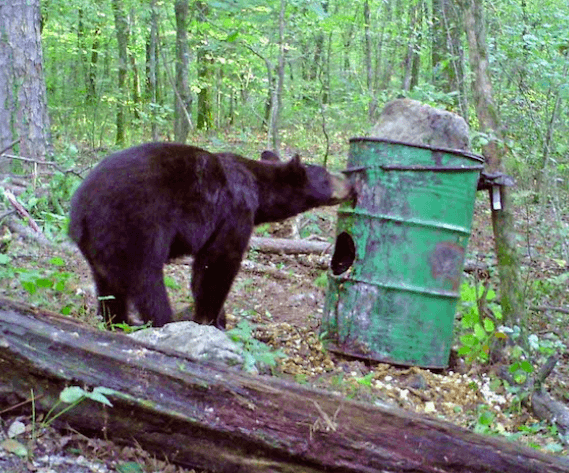
Price of an Alaska Hunting License:
All resident and non-resident hunters must have a valid Alaska hunting license.
The price of an Alaska hunting license varies according on resident status. Prices range from $45 for locals and $160 for non-residents.
Tickets/Tags for Bear Harvest:
Specific harvest permits or tags are necessary for bear hunting, depending on the bear species.
Black Bear Tag:
A black bear harvest ticket/tag is required if you intend to hunt black bears. Non-residents must pay around $450 for a black bear harvest ticket/tag.
Brown Bear Tag:
Price:
For non-residents, the cost of a brown bear harvest ticket/tag can range from $500 to $1,000 or more, depending on the region and hunting unit.
Grizzly Bear Tag:
Price:
For non-residents, the cost of a grizzly bear harvest ticket/tag can range from $500 to $1,000 or more, depending on the region and hunting unit.
Bear harvest ticket/tag prices are subject to change, so visit the Alaska Department of Fish and Game (ADFG) website or contact them directly for the most up-to-date information.
Benefits of using an ebike for your Bear Hunt.
Hunting bears in Alaska can be an amazing and hard experience, and using hunting e-bikes can give hunters an added advantage. In the rough Alaskan tundra, these electric bicycles provide a simple and efficient form of transportation, allowing hunters to cover more land and visit inaccessible hunting regions with ease.
Hunting e-bikes, with their electric-assist capabilities, allow hunters with more range and less physical exertion than traditional means of navigating the terrain. The electric motor supports the rider in pedaling, allowing them to more easily tackle steep inclines and handle bumpy paths. This function is very useful while transporting hunting equipment and wildlife on the bike.
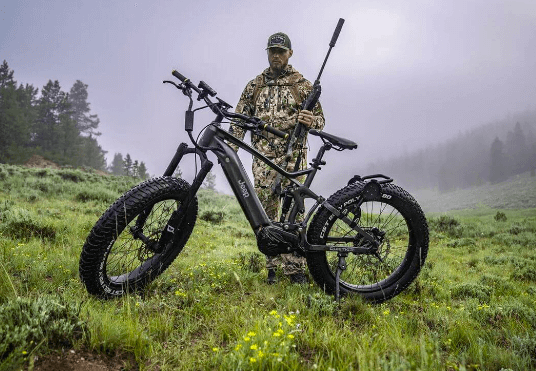
Another advantage of e-bikes for bear hunters is their silent operation. Bears have acute hearing and are often startled by loud noises. E-bikes for hunting make little noise, allowing hunters to approach their hunting sites quietly and boost their chances of reaching within shot range without alerting the bears.
E-bikes also allow hunters to traverse more distances in a shorter amount of time. This is especially helpful when scouting for bear signs or looking for new hunting locations. Hunters may explore a bigger area and discover prospective bear habitats more quickly with the use of an electric motor, boosting their chances of spotting active bear tracks, feeding locations, or bedding sites.
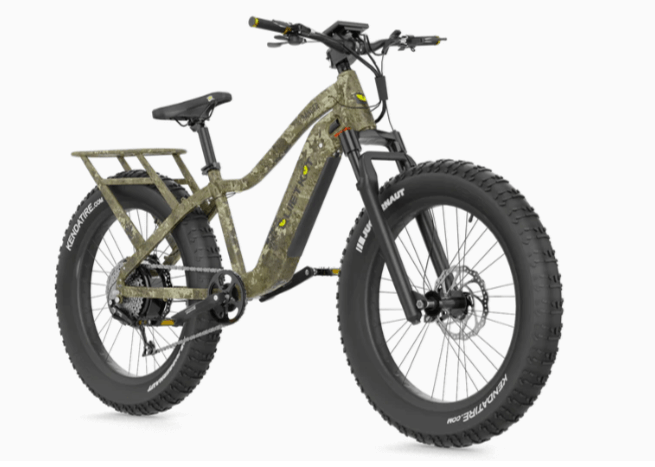
In addition to their practical benefits, hunting e-bikes help to reduce environmental effect. Their electric engines emit no emissions, lowering the carbon impact connected with hunting trips. This is consistent with the ideals of ethical and sustainable hunting, in which hunters aim to reduce their ecological imprint and maintain the natural beauty of Alaska’s wilderness for future generations.
In conclusion, using hunting e-bikes to hunt bears in Alaska can provide hunters with better mobility, less physical strain, improved scouting skills, and reduced environmental effect.
However, hunting restrictions must be followed, safety must be prioritized, and bear hunting must be approached with respect and ethical thought.
Hunting bears on e-bikes may improve the entire hunting experience in the gorgeous Alaskan wilderness with proper planning and appropriate hunting procedures. Also check the Alaska electric bike laws and follow the rules.
2023 Alaska Electric Bike Laws. All You Need To Know.
FAQs About Hunting Bears in Alaska.
Q: What types of bears may I hunt in Alaska?
A: Black bears, brown bears, and polar bears can all be hunted in Alaska.
Q: Do I need a hunting license in Alaska to hunt bears?
A: Yes, you must have a valid Alaska hunting license to hunt bears.
Q: What is the minimum age in Alaska to hunt bears?
A: The minimum age to hunt bears in Alaska is normally 10 years old, however this may vary depending on location.
Q: Is there a season for bear hunting in Alaska?
A: Bear hunting seasons are set for each species of bear and hunting unit. Specific dates may be found at the Alaska Department of Fish and Game.
Q: Are non-residents permitted to hunt bears in Alaska?
A: Non-residents can hunt bears in Alaska, but they must have the appropriate licenses and permits.
Q: Is baiting permitted in Alaska for bear hunting?
A: Baiting is authorized in some places for black bear hunting, but not for brown or polar bears.
Q: Are there any limits on the sort of weapon used to hunt bears?
A: Yes, there are strict laws governing the sorts of weapons, archery equipment, and ammunition permitted for bear hunting. For further information, see the Alaska hunting restrictions.
Q: Are there bear hunting bag limitations in Alaska?
A: Yes, there are bag limitations for each bear species and hunting unit. It is critical to understand and adhere to these boundaries.
Q: Can I utilize a hunting guide in Alaska to go bear hunting?
A: Hiring a hunting guide is not required for either locals or non-residents, although it might be advantageous owing to their expertise and knowledge of the region.
Q: Are there any special rules for retaining bear skins or skulls after a hunt?
A: Yes, the Alaska Department of Fish and Game may demand that the bear’s hide, skull, or other components be sealed or reported. Details can be found in the regulations.
Q: Can I hunt bears in Alaska’s national parks or wildlife refuges?
A: Hunting is generally forbidden in national parks, although certain national wildlife refuges permit restricted bear hunting. For further information, consult the individual refuge regulations.
Q: Do I have to take a bear identification exam before I go bear hunting in Alaska?
A: Yes, hunters must pass a bear identification exam to demonstrate their ability to distinguish between bear species.
Q: Can I use dogs to hunt bears in Alaska?
A: Except in limited subsistence hunting scenarios, hunting bears with dogs is prohibited in Alaska.
Q: Is it illegal to hunt bears near fishing streams or salmon breeding grounds?
A: Yes, there may be rules in place to protect bears that graze on salmon in specific places. Check the rules for any limitations.
Q: Can I hunt bears in Alaska from a boat?
A: Yes, hunting bears from a boat is legal in some locations, although restrictions may apply. Details can be found in the hunting unit regulations.
Q: Is it permissible to hunt bears at night using artificial light?
A: No, using artificial light to hunt bears is forbidden in Alaska.
Q: Can I hunt bears with a crossbow in Alaska?
A: Crossbows are authorized in Alaska for bear hunting, however some restrictions may apply. For further information, consult the hunting restrictions.
Related articles
- Bear Hunting In New York: An Exciting Outdoor Activity.
- Ultimate Guide To Arkansas Bear Hunting: Tips, Regulations, Best Locations.
- Moose Hunting in Vermont’s Breathtaking Wilderness; Majestic Pursuits
- Bear Hunting Vermont; A Comprehensive Guide.
- Exploring the Wilderness: Deer Hunting in Vermont’s Breathtaking Landscapes.



